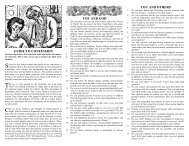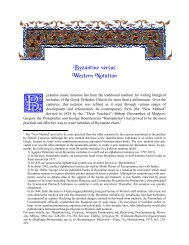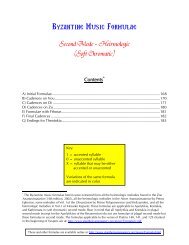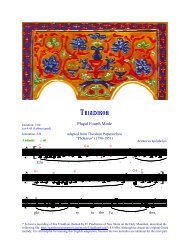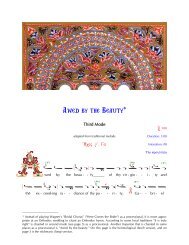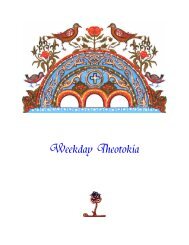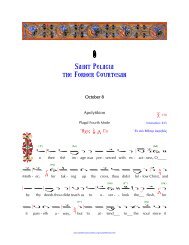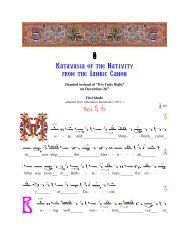Reading Psalmodia (PDF) - St. Anthony's Monastery
Reading Psalmodia (PDF) - St. Anthony's Monastery
Reading Psalmodia (PDF) - St. Anthony's Monastery
You also want an ePaper? Increase the reach of your titles
YUMPU automatically turns print PDFs into web optimized ePapers that Google loves.
ising from Ni through Pa are often sung with the diatonic tuning of Pa.) Is Chrysanthosreflecting a different practice, a subtly different way of singing Tone II?On page 42 of his Introduction Bishop Chrysanthos analyses the scales of two modes ofTone Plagal II:a] The pure hard chromatic scale:Pa.......7..................18...3............12.......7..................18...3Andb] the mixed hard chromatic and diatonic scale:Pa.......7..................18...3............12.........9.......7............12Comparing example a] with the standard modern analysis of the hard chromatic:Pa......6....................20....4............12......6....................20....4suggests that here too Bishop Chysanthos is representing the scale as it is currentlysung. The distribution of intervals is similar, the very small intervals and the very largeintervals occur in corresponding places.The mixed scale represents a common modal variation that usually occurs within apiece, where a melodic passage is based on the upper tetrachord of the diatonic scalerather than that of the hard chromatic. Many Doxastika contain such passages, as doesthe familiar chant of the Antiphon Simeron krematai epi Xylou.On page 47 of the Interpretation Konstantinos asserts that Maqam Segah is Echos Legetos,and Alygizakis (p.216) shows that this Maqam is generally thought to correspond toTone IV. Konstantinos gives the scale of Segah asZo....4............12.........9.......7............12............12.........9|VouThis time the scale he presents seems to represent reasonably well the pattern ofintervals in Tone IV Legetos as it actually sung, though many singers would sharpen thenote Pa more than is suggested here.Kakoulides, in his useful “ΘΕΩΡΙΑ ΚΑΙ ΠΡΑΧΙΣ” Athens, 1988, (p. 63) analyses the scaleof Tone IV showing an ambiguity in the pitch of Ke and Zo. Here are the two versions ofthe scale his diagram implies:a] Vou........8............12............12..........10........8............12..........10b] Vou........8............12..........10............12........8............12..........1016





